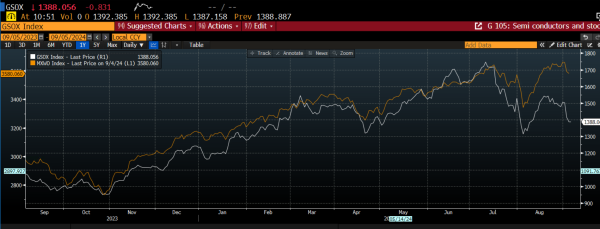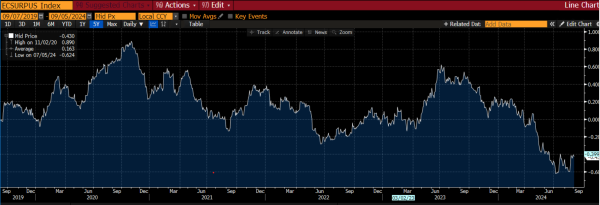Are chip makers decoupling from the broader market?
By Kathleen Brooks, research director at XTB
Stocks markets have mostly stabilized over the last 24 hours. The S&P 500 is pointing to a muted open later today and European stocks are mostly higher on Thursday. Japanese stocks remain under pressure. The Nikkei fell more than 1% on Thursday as renewed strength in the yen weighs on Japanese exporters.
Are AI stocks decoupling from the broader market?
The sell-off from earlier this week suggests that new themes may be emerging in global financial markets. Nvidia and other global chip makers remain under pressure, however, they are decoupling from the main market. The Nasdaq global semiconductor index has been down 20% since mid-July. This compares with a 1.9% decline in the MSCI world index over the same time period, as you can see in the chart below. Thus, the problems that are accumulating for the chip makers, such as antitrust woes, global trade wars and concerns about AI demand may not drag down global markets for the rest of the year.
Nvidia is worth singling out. It does not act like other global semiconductor companies, and it still remains an important component of the S&P 500. Its stock price is down 17% in the last 5 days; however, it is still higher by 15% in the past month. Nvidia’s sell off stabilized on Thursday, but it has not been able to sustain a meaningful recovery. The futures market is predicting a 1% increase in the stock price when the US markets open later today. All eyes will be on whether Nvidia can bounce back, or if it will struggle like other global chip makers. If it struggles, then it could make room for other sectors to take over dominance of the US equity market as we move to the last few months of the year.
Chart 1: Nasdaq global semiconductor index and MSCI world index

Source: XTB and Bloomberg
US economic data supports Fed rate cuts
Economic data is also back in focus. We will send out our payrolls preview later, however, as we lead up to the Fed meeting on 18th September, there is no denying that the economic backdrop is weakening for the US. The latest weak data point was the Jolts jobs report that fell to its lowest level since 2021. The Citi US economic surprise index is close to its lowest level of the year, with a consistent flow of data that is weaker than expected, as you can see in the chart below. Interestingly, even as US economic data has deteriorated, market expectations for a 50bp rate cut from the Federal Reserve this month have declined. For example, there is now a 59% chance of a single rate cut from the Fed to 5-5.25% later this month, with a 41% chance of a 50bp rate cut currently priced in, according to the CME’s Fedwatch tool. A month ago, the prospect of a 50bp rate cut was 85%. The market is still expecting 110bps of cuts from the Fed this year, however, they are backloaded with double rate cuts expected in November and December.
Chart 2: Citi US economic surprise index

Source: Bloomberg and XTB
The Fed may avoid a 50bp rate cut ahead of November’s presidential election, which is why the market is cautious ahead of the September meeting. However, this makes Friday’s US labour market report all the more important, as it could give an indication about whether the Fed will consider larger rate cuts for the rest of the year.
Oil bounces back, but commodities remain vulnerable
Elsewhere, fears of a US economic slowdown could limit any recovery in the oil price, even though Opec+ are reportedly considering delaying increasing production levels. Brent crude oil is higher by more than 1% on Thursday, and is back above $73.50, however, it is still down by 8% over the last 5 days. The depth of the decline in the oil price and across the commodity space in recent weeks suggests that fears of a recession in the US is also a major driver of commodity prices, regardless of what Opec does. It is interesting that the increase in energy prices on Thursday has not led to an uptick in the price of metals. For example, iron ore is down another 1.7% on Thursday and copper is lower by 0.5%. Supply factors are weighing on commodity prices right now, however, if we get a weak payrolls figure, or a less than uber dovish Fed on 18th September, then demand concerns could compound troubles for commodities as we move towards the end of Q3.
UK economic data suggests inflation concerns are easing
Economic data on Thursday has not moved the dial for European equities. Eurozone retail sales were weaker than expected in July, rising only 0.1% MoM. In the UK, the construction sector PMI fell in August to 53.6 from 55.3. Construction is typically weak in August, so we will watch to see if it bounces back in September. Also, Decision Maker Panel inflation expectations for 1 year ahead rose by 0.1% to 2.6% in August up from 2.5% in July. However, the DMP Bank of England report also suggests that wage growth will slow sharply in the coming months. Wage growth in the UK is currently 5.8%, and CFOs from a selection of UK businesses expect wage growth to be 4.1% in a year’s time. Sticky wage growth was a key factor in the BOE taking rate cuts at a slow pace. While 4.1% is still above the BOE’s 2% inflation target, it suggests that the BOE may have room to cut rates at a faster clip. There are currently 5 rate cuts priced in over the next 9 months, and only 46 basis points of cuts priced in by December, less than half the level of the US. This is one of the main reasons why GBP/USD is higher by nearly 3% in the past month. However, if this yield differential is eroded, we think that the pound could be at risk.